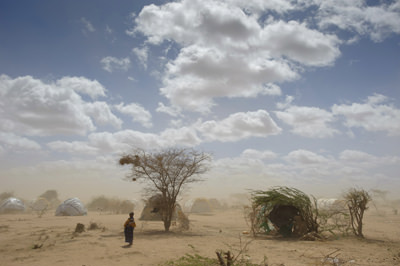World Vision Australia’s MAJELLA HURNEY argues that the world must act now to prevent a disaster threatening the lives of millions across the world – and nowhere more than the Horn of Africa…

While the world’s attention has been focused on the escalating conflict in Syria, another humanitarian crisis is silently unfolding which threatens the lives of an even greater number of people across the globe. It is an impending crisis driven not by the atrocities of war. Its power does not derive from guns or bombs, but from the El Niño phenomenon.
The World Meteorological Organization has warned that we are facing one of the strongest El Niños on record. The surge of heat released periodically from the Pacific Ocean affects global weather patterns, with its greatest impacts felt in the Horn of Africa, parts of Southern Africa, the “dry corridor” of Central America, South East Asia and the Pacific.
 |
|
DEPERATE SITUATION: More than 19.2 million people in the Horn of Africa are facing acute hunger and malnutrition due to the onset of El Niño and the impact of rising global temperatures, which have caused drought and erratic rainfall. “The FAO has warned that the effects of El Niño will differ in the Horn of Africa. Some countries will suffer worsening drought, with crops failing, livestock dying and local food prices soaring. Other countries will experience devastating flash floods. However, one thing is clear: this weather phenomenon poses a major threat to the food security and health of some of the world’s most vulnerable.” |
While the effects of this El Niño will be felt across the globe, the region that is facing the most extreme risk is one that can least afford it: the Horn of Africa.
According to the UN Food and Agriculture Organisation (FAO), over 19.2 million people in the Horn of Africa are facing acute hunger and malnutrition due to the onset of El Niño and the impact of rising global temperatures, which have caused drought and erratic rainfall.
The FAO has warned that the effects of El Niño will differ in the Horn of Africa. Some countries will suffer worsening drought, with crops failing, livestock dying and local food prices soaring. Other countries will experience devastating flash floods. However, one thing is clear: this weather phenomenon poses a major threat to the food security and health of some of the world’s most vulnerable.
The food security situation in Ethiopia is particularly alarming. Over the past decade, Ethiopia has achieved sustained economic growth, nearly doubling the size of its economy. Significant aid investments have been made to build the resilience of rural communities against adverse weather.
But despite these gains, Ethiopia remains highly vulnerable to climatic shocks. Critical dependence on rain-fed agriculture and a rapidly growing population leaves millions of Ethiopians at acute risk of food insecurity. It is currently facing a serious slow-onset emergency as a result of failed spring rains associated with climate change and poor summer rains associated with El Niño.
Alarmingly, the Government of Ethiopia announced on 13th October that the number of people in Ethiopia now in need of emergency food aid has risen to 8.2 million from 4.5 million in August. This number is predicted to rise to a staggering 15 million in 2016 if urgent preventative action is not taken to address the crisis. This figure is close to the number of people in need of aid due to the Syria conflict which is regarded as the largest humanitarian crisis of our times.
The difference between these two crises is that mass loss of life predicted for the Horn of Africa is largely preventable. If urgent action is taken now to support communities suffering food insecurity and malnutrition, we can avert a major humanitarian catastrophe.
We must learn from history. Five years ago, donor governments failed to take early action in response to warning signs of a food crisis slowly unfolding in the Horn of Africa. Governments saw the disaster coming, but did too little too late. As a result, famine was declared in Somalia and more than 13 million people were in need of emergency aid. Tragically, about 260,000 lives were lost which might otherwise have been saved. It was widely acknowledged as an extreme failure of the international humanitarian system.
Not only does early action save lives, it can also save money. While it is too simplistic to assume an overarching cost-benefit ratio, studies have shown that it is more cost effective to take preventative action to avert a food and nutrition crisis, than to respond to one. For example, in the Afar region of Ethiopia, replacing sheep and goats costs at least six times more than providing supplementary feeding to keep them alive, and replacing cattle costs 14 times more. Similarly, the costs of providing food support to prevent severe acute malnutrition are less than clinically treating this condition.
World Vision is working in Ethiopia and other parts of the Horn of Africa to help mitigate the effects of this impending food crisis. This includes measures to sustain drought-resistant crops, keep livestock alive, support increased access to water, emergency food aid and health services. However, aid agencies cannot do this alone. It requires coordinated action on the part of local communities, aid agencies, governments, UN and other multilateral agencies to address this slow-onset crisis. Without funding, we cannot scale-up the action required to prevent mass suffering and loss of life.
In a society where our top rating reality TV shows celebrate food, it is hard to imagine people dying from extreme hunger. But that is the greater reality facing millions of people.
Majella Hurney is a senior humanitarian policy adviser at World Vision Australia. This article, written to mark World Food Day on 16th October, was originally published in The Age newspaper.





